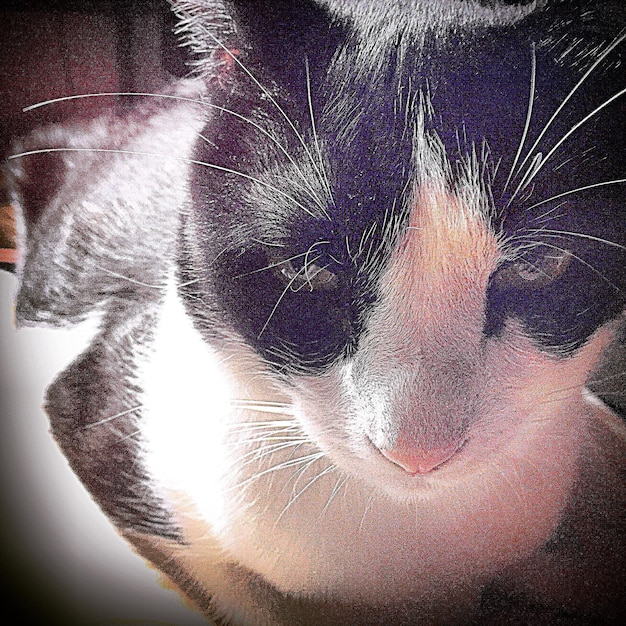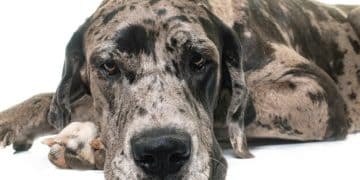Don’t Ignore These Symptoms: Early Warning Signs of Heart Disease in Senior Pets

Recognizing early warning signs of heart disease in senior pets is crucial for timely veterinary intervention, improving their quality of life and potentially extending their lifespan.
As our beloved pets enter their golden years, they become more susceptible to various health issues, including heart disease. Recognizing the early warning signs can make a significant difference in managing their condition and ensuring a comfortable life. Don’t Ignore These Symptoms: Early Warning Signs of Heart Disease in Senior Pets is about knowing what those signs are and what actions to take.
Understanding Heart Disease in Senior Pets
Heart disease in senior pets can manifest in various forms, each with its own set of symptoms. It’s important to be aware of the most common types and how they can affect your furry friend.
Heart disease can be congenital, meaning it’s present from birth, or acquired, developing later in life. In senior pets, acquired heart disease is more common, often caused by the gradual wear and tear on the heart valves or muscle.
Common Types of Heart Disease in Senior Pets
Understanding the different types of heart disease can help you recognize potential symptoms and seek appropriate veterinary care.
- Mitral Valve Disease: This is the most common type of heart disease in dogs, particularly small breeds. The mitral valve, which separates the left atrium and ventricle, becomes thickened and leaky.
- Dilated Cardiomyopathy (DCM): DCM primarily affects large-breed dogs. The heart muscle becomes weak and enlarged, reducing its ability to pump blood effectively.
- Hypertrophic Cardiomyopathy (HCM): Though more common in cats, HCM can also occur in dogs. The heart muscle thickens, making it harder for the heart to relax and fill with blood.
- Arrhythmias: Irregular heartbeats can occur due to various underlying heart conditions. These can range from mild to life-threatening.

Recognizing these types of heart disease is the first step in ensuring your senior pet receives the care they need. Regular veterinary checkups are essential for early detection and management.
Key Symptoms to Watch For
Identifying heart disease in its early stages can significantly improve the prognosis for your senior pet. Keep an eye out for these key symptoms.
Early detection relies on vigilant observation. Changes in your pet’s behavior, activity level, or physical appearance can be subtle but significant indicators of underlying heart issues.
Subtle Signs of Heart Trouble
Sometimes, the early signs of heart disease can be easily overlooked. Learning to recognize these subtle changes is crucial for proactive pet care.
- Coughing: A persistent cough, especially at night or after exercise, can be a sign of fluid buildup in the lungs due to heart failure.
- Difficulty Breathing: Increased respiratory rate or effort, even at rest, is a serious sign and requires immediate veterinary attention.
- Lethargy: A noticeable decrease in energy levels or reluctance to engage in usual activities can indicate heart problems.
- Fainting or Collapse: These episodes can occur due to reduced blood flow to the brain caused by an irregular heartbeat or poor heart function.
Being aware of these signs and promptly consulting with your veterinarian can help in early diagnosis and management of heart disease.
Changes in Breathing Patterns
Breathing patterns are a critical indicator of heart health in senior pets. Monitoring these patterns can provide valuable insights into their condition.
Changes in breathing can be subtle at first but become more pronounced as the disease progresses. Observing your pet’s breathing rate and effort at rest can help you identify potential issues early on.
Recognizing Abnormal Breathing
Knowing what constitutes normal breathing for your pet is essential for spotting deviations that may indicate heart problems.
Normal respiratory rates vary depending on the species and breed, but generally, a resting respiratory rate above 30 breaths per minute in dogs and 40 breaths per minute in cats should raise concern. Watch for signs like:
- Increased Respiratory Rate: Counting breaths per minute while your pet is resting can help identify abnormally high rates.
- Increased Respiratory Effort: Look for exaggerated chest or abdominal movements, flared nostrils, or open-mouth breathing.
- Coughing or Wheezing: These sounds can indicate fluid buildup in the lungs or airway constriction.
If you notice any of these signs, it’s important to seek veterinary attention promptly to determine the underlying cause.
Activity Level and Exercise Intolerance
A pet’s activity level is a good indicator of their overall health. A noticeable decrease in their willingness or ability to exercise can be a sign of heart disease.
Monitor your pet’s energy level during walks, playtime, and other activities. If they tire more easily or show reluctance to participate, it’s worth investigating further.
Signs of Exercise Intolerance
Exercise intolerance can manifest in various ways. Recognizing these signs can help you assess the severity of the problem.
Look for signs like:
- Excessive Panting: Panting more than usual after mild exertion can indicate that their heart is struggling to meet the body’s oxygen demands.
- Weakness or Fatigue: A pet with heart disease may become weak or tire quickly during exercise.
- Coughing or Difficulty Breathing: These signs can also occur during or after exercise, indicating fluid buildup in the lungs.
If your pet exhibits these symptoms, consult with your veterinarian to determine if heart disease is the underlying cause.
Changes in Appetite and Weight
Significant changes in appetite and weight can also be indicators of heart disease in senior pets. Keep a close eye on their eating habits and body condition.
While some fluctuations in appetite and weight are normal, persistent or drastic changes should raise concern. Monitor your pet’s food intake and body weight regularly.

How Heart Disease Affects Appetite and Weight
Heart disease can lead to changes in appetite and weight due to several factors.
- Reduced Appetite: Heart disease can cause nausea or fatigue, leading to a decrease in appetite.
- Weight Loss: In severe cases, heart disease can lead to cardiac cachexia, a condition characterized by muscle wasting and weight loss.
- Fluid Retention: Conversely, some pets with heart disease may experience fluid retention, leading to weight gain despite poor appetite.
If you notice significant changes in your pet’s appetite or weight, it’s important to seek veterinary evaluation to determine the underlying cause and receive appropriate treatment.
When to Seek Veterinary Care
Knowing when to seek veterinary care is crucial for managing heart disease in senior pets. Err on the side of caution and consult with your veterinarian if you notice any concerning symptoms.
Prompt veterinary attention can make a significant difference in diagnosing and managing heart disease. Early intervention can help improve your pet’s quality of life and potentially extend their lifespan.
Urgent Symptoms Requiring Immediate Attention
Some symptoms require immediate veterinary care.
These include:
- Severe Difficulty Breathing: Gasping for air, open-mouth breathing, or blue-tinged gums are signs of a critical emergency.
- Fainting or Collapse: These episodes can indicate a life-threatening arrhythmia or severe heart failure.
- Sudden Weakness or Paralysis: These symptoms may indicate a blood clot in the heart or major blood vessel.
If your pet exhibits any of these symptoms, seek veterinary care immediately.
Diagnostic Tests Your Vet May Perform
Veterinarians use various diagnostic tests to evaluate heart health.
These tests help veterinarians assess the structure and function of the heart, diagnose underlying conditions, and develop appropriate treatment plans. Common tests include:
- Physical Examination: Listening to the heart and lungs with a stethoscope can reveal murmurs, arrhythmias, or abnormal lung sounds.
- Radiography (X-rays): Chest X-rays can help assess the size and shape of the heart and evaluate the lungs for fluid buildup.
- Echocardiography (Ultrasound): This test provides detailed images of the heart’s structure and function, allowing veterinarians to assess valve function, heart muscle thickness, and blood flow.
- Electrocardiography (ECG): An ECG records the electrical activity of the heart and can help identify arrhythmias or other abnormalities in heart rhythm.
| Key Sign | Brief Description |
|---|---|
| 🫀 Coughing | Persistent cough, especially at night, may indicate fluid in the lungs. |
| 😮💨 Breathing Difficulty | Increased breathing rate or effort, even at rest, requires immediate vet care. |
| 😴 Lethargy | Decrease in energy levels or reluctance to play can signal heart issues. |
| ⚖️ Weight Changes | Sudden weight loss or gain despite normal appetite indicates heart disease. |
Frequently Asked Questions (FAQs)
▼
Count the number of breaths your pet takes in 15 seconds while they are resting, then multiply by four to get the breaths per minute. Do this when they are calm and in a familiar environment for an accurate reading.
▼
Risk factors include breed predisposition, age, obesity, and poor dental hygiene. Certain breeds like Cavalier King Charles Spaniels are more prone to mitral valve disease.
▼
In most cases, heart disease in pets cannot be cured, but it can be managed with medication and lifestyle changes to improve quality of life. Early detection is key.
▼
A low-sodium diet is often recommended to help reduce fluid retention. Your veterinarian can recommend a specific diet tailored to your pet’s needs and heart condition.
▼
Senior pets should have a vet checkup at least every six months to monitor for any health issues, including heart disease. Regular checkups can help catch problems early.
Conclusion
Being vigilant about the health of your senior pets and recognizing the early warning signs of heart disease can significantly impact their quality of life. If you observe any of the symptoms discussed, prompt veterinary attention is crucial. Regular checkups, a healthy lifestyle, and a watchful eye can ensure your furry friends enjoy their golden years to the fullest.





